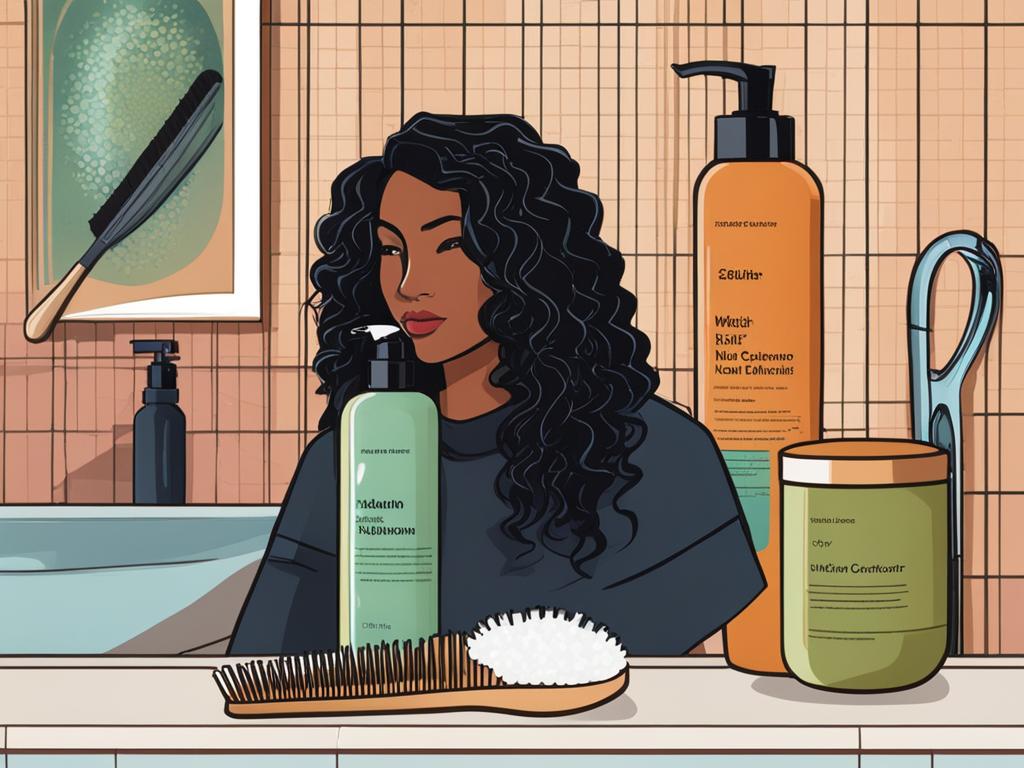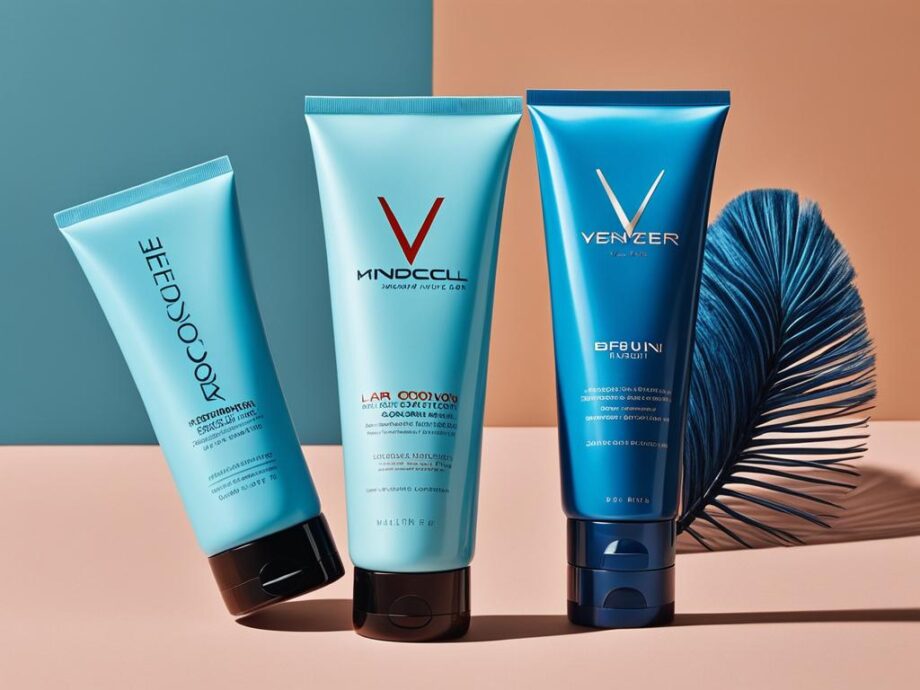Are you tired of using the wrong hair products and not getting the desired results? Two popular treatments for hair care are leave-in conditioners and hair masks, but are they interchangeable? What’s the difference between these treatments?
In this article, we break down the key differences between leave-in conditioners and hair masks so that you can find the ideal treatment for your luscious locks.
Key Takeaways
- Leave-in conditioners and hair masks serve different purposes.
- Leave-in conditioners are beneficial for daily use and repairing damaged hair.
- Hair masks are ideal for deep conditioning and addressing specific hair concerns.
- The choice between leave-in conditioner and hair mask depends on your hair type, concerns, and desired results.
- Both treatments can be used in conjunction for optimal results.
Benefits of Using Leave-In Conditioner
If you’re looking to keep your hair healthy and luscious, adding a leave-in conditioner to your routine can work wonders. Here are some benefits of incorporating a leave-in conditioner into your hair care regimen:
- Hydration: Leave-in conditioners are great for hydrating your hair, providing it with an extra layer of moisture. They can help to keep your locks looking sleek and smooth, especially if you have dry or damaged hair.
- Nourishment: Because leave-in conditioners are not washed out, they can provide your hair with ongoing nourishment and protection. They can also help to detangle your hair, making it easier to manage.
- Repair: Leave-in conditioners can help repair damaged hair by restoring lost nutrients and protecting it from further damage. Your hair will look and feel healthier after just a few uses.
- Convenience: Since leave-in conditioners are not rinsed out, they are a convenient way to moisturize and condition your hair. You can apply them throughout the day or leave them in overnight, for maximum effect.
If you have damaged hair, a leave-in conditioner is an excellent way to help it on its road to recovery. With regular use, your hair will be stronger, healthier, and more manageable.
Benefits of Using Hair Mask
If you have dry, damaged hair, incorporating a hair mask into your routine can provide numerous benefits. Hair masks are specially formulated to provide deep conditioning and repair to your hair. Some of the key benefits of using a hair mask include:
- Intense hydration:
Hair masks are designed to penetrate deeply into the hair shaft, delivering much-needed moisture to your strands. This added hydration can help to prevent breakage and leave your hair feeling soft and silky. - Restoration of natural oils:
If your hair is prone to dryness, a hair mask can help to restore your hair’s natural oils. This can improve the overall health of your hair and prevent future damage. - Repair of damage:
Hair masks can also repair damage caused by heat styling, sun exposure, and other environmental factors. This is especially important if you have dyed or chemically-treated hair that requires extra care.
There are a wide variety of hair masks available to address different hair concerns. Some hair masks are formulated specifically for dry hair, while others may be designed to add volume or promote hair growth. When choosing a hair mask, be sure to consider your specific needs and hair type.

Choosing Between Leave-In Conditioner and Hair Mask
When it comes to choosing between a leave-in conditioner and a hair mask, there are several factors to consider:
Hair Texture
Your hair texture plays a significant role in determining which treatment is best suited for your hair. If you have thin or fine hair, a leave-in conditioner may be a better option as it provides lightweight hydration without weighing your hair down. On the other hand, if you have thick or coarse hair, a hair mask can provide the intense hydration and nourishment your hair needs.
Moisture Level
If your hair is consistently dry and brittle, a hair mask can help restore moisture and promote overall hair health. However, if your hair is already relatively healthy and you’re looking to maintain that moisture balance, a leave-in conditioner can help keep your hair hydrated without overloading it with heavy treatments.
Treatment Goals
Consider your treatment goals when deciding between a leave-in conditioner and a hair mask. If you’re looking to address specific hair concerns, such as breakage or split ends, a hair mask can provide targeted repair and nourishment. However, if you’re simply looking to maintain healthy hair and prevent damage, a leave-in conditioner can be an excellent daily treatment option.

Ultimately, the choice between a leave-in conditioner and a hair mask depends on your hair goals and specific needs. Incorporating both treatments into your hair care routine can provide optimal results and ensure your hair stays healthy and hydrated.
When to Use Leave-In Conditioner and Hair Mask
Both leave-in conditioners and hair masks offer various benefits to enhance your hair’s health and appearance. The key difference between them is their intensity and ideal frequency of use.
When to Use Leave-In Conditioner
Leave-in conditioner is perfect for daily use. It provides a lightweight formula that moisturizes and protects your hair without causing buildup. Use leave-in conditioners throughout the day to nourish and protect your hair against harsh UV rays or environmental factors.
Pro Tip: Apply leave-in conditioners after showering when your hair is damp for better absorption. Always start by applying a small amount to your fingertips before spreading it evenly throughout your hair strands.
When to Use Hair Mask
Hair masks are ideal for deep conditioning and repairing damaged hair. They provide intense hydration, nourishment, and restoration to your hair. Use hair masks once a week or as needed, depending on your hair’s condition and needs. If your hair is particularly dry, you can use hair masks twice a week.
Pro Tip: Apply hair masks when your hair is clean and damp. Use your fingertips to massage the mask into your scalp and hair strands. Leave it on for 10-15 minutes before rinsing out with lukewarm water.
Knowing when to use leave-in conditioner or hair masks can help in achieving optimal hair health. By incorporating both into your hair care routine, you can experience the benefits of nourished, moisturized, and protected hair.

Conclusion
In conclusion, both leave-in conditioners and hair masks can be beneficial for maintaining healthy hair. Choosing between the two treatments will depend on your hair type, concerns, and desired results.
Leave-in conditioners are ideal for daily use and can provide additional nourishment and hydration, particularly for damaged hair. Hair masks are more intensive treatments that can deeply condition and repair dry hair and address specific hair concerns.
By experimenting with both leave-in conditioners and hair masks, you can find the perfect balance for your hair’s unique needs. Incorporating these treatments into your hair care routine can help you achieve the healthy, luscious locks you’ve always wanted.
FAQ
What is the difference between a leave-in conditioner and a hair mask?
A leave-in conditioner is a lightweight product that is applied to damp or dry hair and left in without rinsing. It provides ongoing hydration, detangling, and protection from environmental damage. On the other hand, a hair mask is a more concentrated treatment that is typically used once a week or as needed to deeply condition, repair, and nourish the hair. It is usually left on for a specific period and then rinsed out.
What are the benefits of using a leave-in conditioner?
Using a leave-in conditioner can provide numerous benefits for the hair. It helps to detangle knots, reduce frizz, and add moisture and shine. Leave-in conditioners also offer protection against heat damage from styling tools and can help repair and strengthen damaged hair, promoting healthier overall hair quality.
What are the benefits of using a hair mask?
Hair masks are designed to provide intense hydration, repair damage, and address specific hair concerns. They can replenish moisture in dry hair, improve elasticity, reduce breakage, and restore the hair’s natural shine and smoothness. Hair masks are particularly beneficial for individuals with dry, damaged, or chemically treated hair.
How do I choose between a leave-in conditioner and a hair mask?
Choosing between a leave-in conditioner and a hair mask depends on your hair type, concerns, and desired results. If you have relatively healthy hair and want to maintain its overall health and manageability, a leave-in conditioner may be sufficient. However, if your hair is damaged, dry, or in need of intense repair, a hair mask can provide more targeted treatment. It’s essential to consider your hair’s specific needs and your desired outcome.
When should I use a leave-in conditioner and when should I use a hair mask?
Leave-in conditioners are typically used daily or as needed after washing and conditioning the hair. They provide ongoing moisture and protection throughout the day. Hair masks, on the other hand, are recommended for weekly or occasional use when more intensive treatment is required. They can be beneficial after exposure to harsh weather conditions, regular heat styling, or when the hair feels dry, brittle, or damaged.
Can I use a leave-in conditioner for damaged hair?
Yes, leave-in conditioners are suitable for damaged hair. They can help repair and strengthen damaged hair strands, restore moisture, and minimize further damage. Look for leave-in conditioners that include ingredients like keratin, protein, and essential oils, as these can provide additional nourishment and repair benefits for damaged hair.
Is a hair mask suitable for dry hair?
Yes, hair masks are specifically designed to address the needs of dry hair. They contain deeply moisturizing ingredients that can hydrate and restore dry, brittle hair, increasing its softness and manageability. Regular use of a hair mask can help replenish moisture and improve the overall health and appearance of dry hair.
